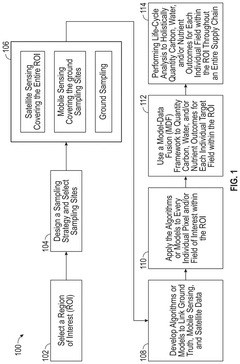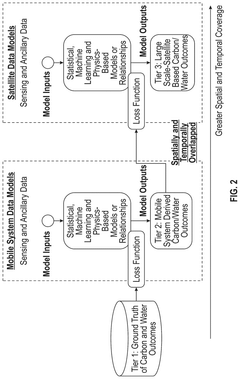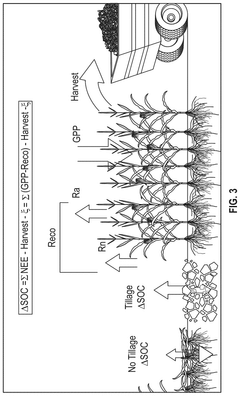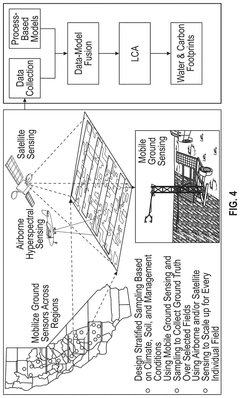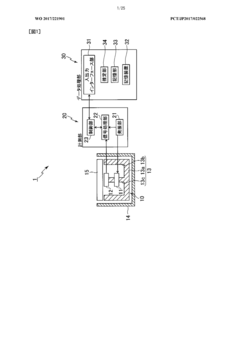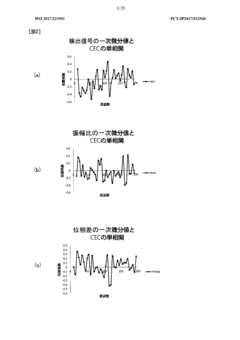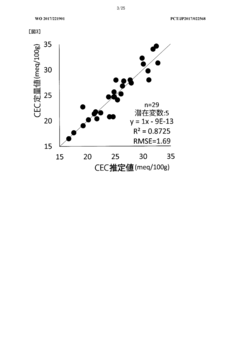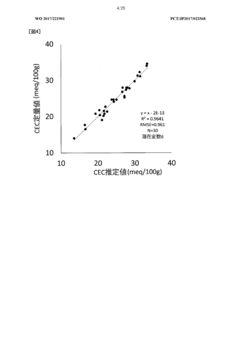Quantum Computing in Agricultural Soil Fertility Modelling
JUL 17, 20259 MIN READ
Generate Your Research Report Instantly with AI Agent
Patsnap Eureka helps you evaluate technical feasibility & market potential.
Quantum Agri-Computing Evolution and Objectives
Quantum computing has emerged as a revolutionary technology with the potential to transform various industries, including agriculture. The evolution of quantum computing in agricultural soil fertility modeling represents a significant leap forward in our ability to understand and optimize complex soil systems. This technological advancement aims to address the growing challenges in sustainable agriculture and food security.
The journey of quantum computing in agriculture began with the recognition that classical computing methods were insufficient to model the intricate interactions within soil ecosystems. Traditional soil fertility models often struggled to account for the multitude of variables and their non-linear relationships. As quantum computing research progressed, scientists and agronomists began to explore its application in simulating soil processes at the molecular level.
The primary objective of integrating quantum computing into agricultural soil fertility modeling is to develop more accurate and comprehensive models that can predict soil behavior under various conditions. These models aim to optimize nutrient management, enhance crop yields, and promote sustainable farming practices. By leveraging the power of quantum algorithms, researchers seek to simulate complex quantum mechanical effects that influence soil chemistry and microbial activity.
One of the key goals is to create quantum-enhanced soil sensors capable of real-time analysis of soil composition and health. These sensors would utilize quantum sensing technologies to detect minute changes in soil properties, providing farmers with unprecedented insights into their fields. This data, when processed through quantum algorithms, could enable precise and timely interventions in soil management.
Another critical objective is the development of quantum-inspired optimization algorithms for resource allocation in agriculture. These algorithms could revolutionize irrigation strategies, fertilizer application, and crop rotation planning by considering a vast array of interdependent factors simultaneously. The ultimate aim is to maximize agricultural productivity while minimizing environmental impact.
As the field progresses, researchers are also focusing on integrating quantum machine learning techniques with soil fertility modeling. This combination promises to uncover hidden patterns in soil data that were previously undetectable, leading to more robust predictive models. The long-term vision is to create a quantum-powered digital twin of agricultural ecosystems, allowing for sophisticated simulations and scenario planning.
The evolution of quantum agri-computing faces several challenges, including the need for error correction in quantum systems and the development of quantum-classical hybrid algorithms suitable for soil modeling. However, the potential benefits in terms of food security, environmental sustainability, and economic efficiency continue to drive innovation in this field.
The journey of quantum computing in agriculture began with the recognition that classical computing methods were insufficient to model the intricate interactions within soil ecosystems. Traditional soil fertility models often struggled to account for the multitude of variables and their non-linear relationships. As quantum computing research progressed, scientists and agronomists began to explore its application in simulating soil processes at the molecular level.
The primary objective of integrating quantum computing into agricultural soil fertility modeling is to develop more accurate and comprehensive models that can predict soil behavior under various conditions. These models aim to optimize nutrient management, enhance crop yields, and promote sustainable farming practices. By leveraging the power of quantum algorithms, researchers seek to simulate complex quantum mechanical effects that influence soil chemistry and microbial activity.
One of the key goals is to create quantum-enhanced soil sensors capable of real-time analysis of soil composition and health. These sensors would utilize quantum sensing technologies to detect minute changes in soil properties, providing farmers with unprecedented insights into their fields. This data, when processed through quantum algorithms, could enable precise and timely interventions in soil management.
Another critical objective is the development of quantum-inspired optimization algorithms for resource allocation in agriculture. These algorithms could revolutionize irrigation strategies, fertilizer application, and crop rotation planning by considering a vast array of interdependent factors simultaneously. The ultimate aim is to maximize agricultural productivity while minimizing environmental impact.
As the field progresses, researchers are also focusing on integrating quantum machine learning techniques with soil fertility modeling. This combination promises to uncover hidden patterns in soil data that were previously undetectable, leading to more robust predictive models. The long-term vision is to create a quantum-powered digital twin of agricultural ecosystems, allowing for sophisticated simulations and scenario planning.
The evolution of quantum agri-computing faces several challenges, including the need for error correction in quantum systems and the development of quantum-classical hybrid algorithms suitable for soil modeling. However, the potential benefits in terms of food security, environmental sustainability, and economic efficiency continue to drive innovation in this field.
Market Demand for Precision Agriculture Solutions
The precision agriculture market has been experiencing significant growth, driven by the increasing demand for sustainable farming practices and the need to optimize crop yields. As global population continues to rise, the pressure on agricultural systems to produce more food with fewer resources intensifies. This has created a fertile ground for innovative solutions that can enhance agricultural productivity, with quantum computing in soil fertility modeling emerging as a promising frontier.
The market for precision agriculture solutions is projected to expand rapidly in the coming years, with soil fertility management being a crucial component. Farmers and agribusinesses are increasingly recognizing the value of data-driven decision-making in soil management, as it directly impacts crop yields and resource efficiency. This has led to a growing interest in advanced modeling techniques that can provide more accurate and timely insights into soil health and fertility.
Quantum computing offers the potential to revolutionize soil fertility modeling by processing complex environmental data at unprecedented speeds and scales. This capability aligns well with the precision agriculture sector's need for real-time, field-specific recommendations. The market is showing particular interest in solutions that can integrate multiple data sources, including satellite imagery, sensor data, and historical crop performance, to create comprehensive soil fertility models.
There is a notable demand for tools that can predict and optimize fertilizer application, as this represents a significant cost for farmers and has substantial environmental implications. Quantum-enhanced models could potentially offer more precise recommendations for nutrient management, reducing waste and improving crop yields. This aligns with the broader trend towards sustainable agriculture and the increasing regulatory pressure to minimize environmental impacts of farming practices.
The adoption of quantum computing in agricultural soil fertility modeling is also being driven by the need for better risk management in the face of climate change. Farmers are seeking more sophisticated predictive models that can account for complex climate patterns and their effects on soil health. This demand is particularly strong in regions facing water scarcity or extreme weather events, where optimal soil management is critical for maintaining agricultural productivity.
While the market for quantum computing in agricultural applications is still in its early stages, there is growing interest from both large agribusinesses and technology companies. Investors are beginning to recognize the potential of this technology to address long-standing challenges in agriculture, leading to increased funding for research and development in this area. As the technology matures and demonstrates its value in real-world applications, the market demand is expected to accelerate, potentially reshaping the landscape of precision agriculture solutions.
The market for precision agriculture solutions is projected to expand rapidly in the coming years, with soil fertility management being a crucial component. Farmers and agribusinesses are increasingly recognizing the value of data-driven decision-making in soil management, as it directly impacts crop yields and resource efficiency. This has led to a growing interest in advanced modeling techniques that can provide more accurate and timely insights into soil health and fertility.
Quantum computing offers the potential to revolutionize soil fertility modeling by processing complex environmental data at unprecedented speeds and scales. This capability aligns well with the precision agriculture sector's need for real-time, field-specific recommendations. The market is showing particular interest in solutions that can integrate multiple data sources, including satellite imagery, sensor data, and historical crop performance, to create comprehensive soil fertility models.
There is a notable demand for tools that can predict and optimize fertilizer application, as this represents a significant cost for farmers and has substantial environmental implications. Quantum-enhanced models could potentially offer more precise recommendations for nutrient management, reducing waste and improving crop yields. This aligns with the broader trend towards sustainable agriculture and the increasing regulatory pressure to minimize environmental impacts of farming practices.
The adoption of quantum computing in agricultural soil fertility modeling is also being driven by the need for better risk management in the face of climate change. Farmers are seeking more sophisticated predictive models that can account for complex climate patterns and their effects on soil health. This demand is particularly strong in regions facing water scarcity or extreme weather events, where optimal soil management is critical for maintaining agricultural productivity.
While the market for quantum computing in agricultural applications is still in its early stages, there is growing interest from both large agribusinesses and technology companies. Investors are beginning to recognize the potential of this technology to address long-standing challenges in agriculture, leading to increased funding for research and development in this area. As the technology matures and demonstrates its value in real-world applications, the market demand is expected to accelerate, potentially reshaping the landscape of precision agriculture solutions.
Quantum Computing in Soil Modeling: Current State
Quantum computing in soil modeling is currently in its nascent stages, with researchers and scientists exploring its potential applications in agricultural soil fertility modeling. The integration of quantum computing techniques into soil modeling promises to revolutionize our understanding of complex soil systems and enhance our ability to predict and manage soil fertility.
At present, the primary focus of quantum computing in soil modeling is on developing quantum algorithms that can efficiently simulate soil processes and interactions. These algorithms aim to overcome the limitations of classical computing methods in handling the vast number of variables and complex interactions within soil ecosystems. Quantum superposition and entanglement are being leveraged to model multiple soil parameters simultaneously, potentially leading to more accurate and comprehensive soil fertility models.
Several research institutions and tech companies are actively investigating the application of quantum computing in soil modeling. IBM, for instance, has been exploring the use of its quantum computers to simulate soil organic matter decomposition and nutrient cycling. Similarly, academic institutions such as MIT and the University of Waterloo are conducting research on quantum algorithms for environmental modeling, including soil systems.
The current state of quantum computing in soil modeling is characterized by proof-of-concept studies and small-scale simulations. Researchers are working on quantum-inspired algorithms that can be run on both quantum and classical computers, allowing for the development and testing of models before full-scale quantum hardware becomes widely available. These hybrid approaches are crucial in bridging the gap between theoretical quantum advantages and practical applications in soil fertility modeling.
One of the key challenges in the current state of quantum computing for soil modeling is the limited number of qubits available in existing quantum computers. This constraint restricts the complexity of soil models that can be simulated using quantum systems. However, rapid advancements in quantum hardware development are gradually increasing the number of qubits and reducing error rates, paving the way for more sophisticated soil modeling applications in the near future.
Despite these challenges, the potential of quantum computing in soil modeling has garnered significant interest from the agricultural sector. Precision agriculture companies and large-scale farming operations are closely monitoring developments in this field, recognizing the potential for quantum-enhanced soil fertility models to optimize crop yields, reduce fertilizer use, and improve sustainable farming practices.
In summary, while quantum computing in soil modeling is still in its early stages, it shows promising potential for transforming agricultural soil fertility modeling. The current state is marked by ongoing research, algorithm development, and small-scale demonstrations, with a clear trajectory towards more powerful and practical applications as quantum hardware continues to evolve.
At present, the primary focus of quantum computing in soil modeling is on developing quantum algorithms that can efficiently simulate soil processes and interactions. These algorithms aim to overcome the limitations of classical computing methods in handling the vast number of variables and complex interactions within soil ecosystems. Quantum superposition and entanglement are being leveraged to model multiple soil parameters simultaneously, potentially leading to more accurate and comprehensive soil fertility models.
Several research institutions and tech companies are actively investigating the application of quantum computing in soil modeling. IBM, for instance, has been exploring the use of its quantum computers to simulate soil organic matter decomposition and nutrient cycling. Similarly, academic institutions such as MIT and the University of Waterloo are conducting research on quantum algorithms for environmental modeling, including soil systems.
The current state of quantum computing in soil modeling is characterized by proof-of-concept studies and small-scale simulations. Researchers are working on quantum-inspired algorithms that can be run on both quantum and classical computers, allowing for the development and testing of models before full-scale quantum hardware becomes widely available. These hybrid approaches are crucial in bridging the gap between theoretical quantum advantages and practical applications in soil fertility modeling.
One of the key challenges in the current state of quantum computing for soil modeling is the limited number of qubits available in existing quantum computers. This constraint restricts the complexity of soil models that can be simulated using quantum systems. However, rapid advancements in quantum hardware development are gradually increasing the number of qubits and reducing error rates, paving the way for more sophisticated soil modeling applications in the near future.
Despite these challenges, the potential of quantum computing in soil modeling has garnered significant interest from the agricultural sector. Precision agriculture companies and large-scale farming operations are closely monitoring developments in this field, recognizing the potential for quantum-enhanced soil fertility models to optimize crop yields, reduce fertilizer use, and improve sustainable farming practices.
In summary, while quantum computing in soil modeling is still in its early stages, it shows promising potential for transforming agricultural soil fertility modeling. The current state is marked by ongoing research, algorithm development, and small-scale demonstrations, with a clear trajectory towards more powerful and practical applications as quantum hardware continues to evolve.
Quantum Algorithms for Soil Fertility Analysis
01 Quantum computing for soil analysis
Quantum computing techniques are applied to analyze complex soil data, including nutrient composition, microbial activity, and physical properties. This advanced computational approach enables more accurate and efficient assessment of soil fertility, leading to optimized agricultural practices and improved crop yields.- Quantum computing for soil analysis: Quantum computing techniques are applied to analyze complex soil data, including nutrient composition, microbial activity, and physical properties. This advanced computational approach enables more accurate and efficient assessment of soil fertility, leading to optimized agricultural practices and improved crop yields.
- Soil fertility prediction models: Quantum algorithms are used to develop sophisticated prediction models for soil fertility. These models incorporate various environmental factors, historical data, and real-time sensor inputs to forecast soil nutrient levels, pH balance, and overall fertility status, allowing farmers to make data-driven decisions for soil management.
- Quantum-enhanced precision agriculture: Quantum computing is integrated into precision agriculture systems to optimize fertilizer application, irrigation scheduling, and crop rotation plans. This approach considers multiple variables simultaneously, resulting in more sustainable farming practices and reduced environmental impact.
- Quantum-assisted soil microbiome analysis: Quantum algorithms are employed to analyze complex soil microbiome data, providing insights into the interactions between microorganisms and soil fertility. This advanced analysis helps in developing targeted strategies for enhancing beneficial microbial activity and improving overall soil health.
- Quantum-based soil sensor optimization: Quantum computing techniques are used to optimize the design and placement of soil sensors, enhancing the accuracy and efficiency of data collection. This approach enables real-time monitoring of soil conditions, allowing for rapid adjustments to fertility management strategies and improved resource allocation.
02 Soil fertility prediction using quantum algorithms
Quantum algorithms are developed to predict soil fertility trends based on historical data and environmental factors. These algorithms can process vast amounts of information simultaneously, providing farmers with more precise forecasts for soil management and crop planning.Expand Specific Solutions03 Quantum sensors for real-time soil monitoring
Quantum sensors are utilized to monitor soil conditions in real-time, measuring parameters such as moisture content, pH levels, and nutrient availability. These highly sensitive sensors provide continuous data streams for more responsive and adaptive soil fertility management.Expand Specific Solutions04 Quantum-inspired optimization for fertilizer application
Quantum-inspired optimization algorithms are employed to determine the most efficient fertilizer application strategies. These algorithms consider multiple variables, including soil type, crop requirements, and environmental factors, to minimize waste and maximize nutrient uptake.Expand Specific Solutions05 Integration of quantum computing with precision agriculture
Quantum computing is integrated with precision agriculture systems to enhance overall farm management. This integration allows for more sophisticated analysis of soil fertility data in conjunction with other factors such as weather patterns, crop genetics, and market trends, leading to more holistic and sustainable farming practices.Expand Specific Solutions
Key Players in Quantum Agri-Tech
The quantum computing landscape in agricultural soil fertility modeling is in its early stages, with significant potential for growth. The market size is expanding as agriculture increasingly adopts advanced technologies. While quantum computing is still emerging, its application in soil modeling shows promise for enhancing precision agriculture. Companies like IBM, Google, and Zapata Computing are at the forefront of quantum technology development, while agricultural giants such as The Climate Corp. and Monsanto are exploring its applications in soil science. The convergence of quantum computing and agriculture is creating a competitive environment where tech firms and agribusinesses are collaborating to leverage this cutting-edge technology for improved soil fertility management and crop yield optimization.
The Climate Corp.
Technical Solution: The Climate Corp., a subsidiary of Bayer, is integrating quantum computing into its digital agriculture platform to enhance soil fertility modeling. Their approach combines quantum algorithms with their extensive agricultural data sets and machine learning models. The company is exploring quantum-inspired optimization techniques to improve their FieldView platform's soil analysis capabilities[9]. By leveraging quantum computing, The Climate Corp. aims to model complex soil-plant-atmosphere interactions more accurately, considering factors such as water movement, nutrient uptake, and microbial activity. Their quantum-enhanced models are designed to provide farmers with more precise recommendations for fertilizer application, irrigation, and crop rotation to maximize soil fertility and crop yields[10]. The company is also investigating quantum machine learning algorithms to detect patterns in soil health data that are too complex for classical computers to efficiently process.
Strengths: Extensive agricultural domain expertise, large-scale farm data access, and established digital agriculture platform. Weaknesses: Relatively new to quantum computing, potentially limiting the depth of quantum integration in the short term.
Zapata Computing, Inc.
Technical Solution: Zapata Computing specializes in quantum software and algorithms, applying these to various fields including agricultural soil fertility modeling. Their approach focuses on developing quantum-inspired algorithms that can run on both quantum and classical systems. For soil fertility modeling, Zapata uses quantum approximate optimization algorithms (QAOA) to solve complex optimization problems related to nutrient distribution and soil management[7]. Their quantum machine learning models analyze historical soil data, weather patterns, and crop yields to predict future soil fertility trends. Zapata's software platform, Orquestra, integrates quantum and classical computing resources, allowing for hybrid solutions that can tackle large-scale soil modeling problems. The company is also exploring quantum annealing techniques to simulate soil particle interactions and their impact on fertility[8].
Strengths: Specialized quantum software expertise, flexible hybrid quantum-classical approach, and focus on near-term quantum applications. Weaknesses: Reliance on third-party quantum hardware and limited direct agricultural domain knowledge.
Quantum-Classical Hybrid Models for Agriculture
Methods to estimate field-level carbon, water and nutrient implications for agriculture
PatentPendingUS20250173749A1
Innovation
- A system and method that collect data through ground sampling, remote sensing, and satellite sensing, developing models to fuse this data and perform life-cycle analysis, enabling scalable quantification of carbon, water, and nutrient outcomes at field level across entire regions.
Soil analyzing device and soil analyzing method
PatentWO2017221901A1
Innovation
- A soil analysis device and method utilizing a sensor with a coil to apply an alternating magnetic field, processing detection signals to estimate soil fertility traits, including CEC, through amplitude and phase analysis, and combining this with fluorescence spectroscopy data for more accurate assessments.
Environmental Impact of Quantum-Driven Agriculture
The integration of quantum computing in agricultural soil fertility modeling has the potential to revolutionize farming practices, leading to significant environmental impacts. Quantum-driven agriculture could optimize resource utilization, reducing the overuse of fertilizers and pesticides that contribute to soil degradation and water pollution. By accurately predicting soil nutrient needs, farmers can apply precise amounts of fertilizers, minimizing runoff and groundwater contamination.
Quantum computing's ability to process complex environmental data could enhance our understanding of soil microbiomes and their role in carbon sequestration. This knowledge could lead to farming practices that actively promote carbon storage in soil, mitigating climate change effects. Additionally, improved modeling of soil-plant interactions could result in the development of crop varieties better adapted to local conditions, reducing the need for intensive irrigation and soil amendments.
The environmental benefits extend beyond the farm level. Quantum-driven precision agriculture could lead to more efficient land use, potentially reducing the pressure to convert natural habitats into farmland. This could help preserve biodiversity and maintain crucial ecosystem services. Furthermore, by optimizing crop yields and reducing waste, quantum computing could contribute to food security while minimizing the agricultural sector's environmental footprint.
However, the widespread adoption of quantum computing in agriculture also raises concerns about energy consumption. The operation of quantum computers requires significant energy inputs, which could potentially offset some of the environmental gains if not sourced from renewable energy. There is also the risk of creating a technological divide, where only large-scale industrial farms can afford to implement quantum-driven solutions, potentially marginalizing small-scale farmers and traditional agricultural practices that often have lower environmental impacts.
In the long term, quantum-driven agriculture could facilitate a shift towards more sustainable farming systems. By enabling more accurate predictions of climate patterns and extreme weather events, it could help farmers adapt to climate change, reducing crop losses and the need for emergency interventions that often have negative environmental consequences. The technology could also support the development of closed-loop agricultural systems, where waste is minimized, and resources are recycled efficiently, aligning agricultural practices more closely with natural ecological processes.
Quantum computing's ability to process complex environmental data could enhance our understanding of soil microbiomes and their role in carbon sequestration. This knowledge could lead to farming practices that actively promote carbon storage in soil, mitigating climate change effects. Additionally, improved modeling of soil-plant interactions could result in the development of crop varieties better adapted to local conditions, reducing the need for intensive irrigation and soil amendments.
The environmental benefits extend beyond the farm level. Quantum-driven precision agriculture could lead to more efficient land use, potentially reducing the pressure to convert natural habitats into farmland. This could help preserve biodiversity and maintain crucial ecosystem services. Furthermore, by optimizing crop yields and reducing waste, quantum computing could contribute to food security while minimizing the agricultural sector's environmental footprint.
However, the widespread adoption of quantum computing in agriculture also raises concerns about energy consumption. The operation of quantum computers requires significant energy inputs, which could potentially offset some of the environmental gains if not sourced from renewable energy. There is also the risk of creating a technological divide, where only large-scale industrial farms can afford to implement quantum-driven solutions, potentially marginalizing small-scale farmers and traditional agricultural practices that often have lower environmental impacts.
In the long term, quantum-driven agriculture could facilitate a shift towards more sustainable farming systems. By enabling more accurate predictions of climate patterns and extreme weather events, it could help farmers adapt to climate change, reducing crop losses and the need for emergency interventions that often have negative environmental consequences. The technology could also support the development of closed-loop agricultural systems, where waste is minimized, and resources are recycled efficiently, aligning agricultural practices more closely with natural ecological processes.
Data Security in Quantum Agricultural Systems
As quantum computing continues to advance and find applications in various sectors, including agriculture, the need for robust data security measures becomes paramount. Quantum agricultural systems, which leverage quantum computing for tasks such as soil fertility modeling, handle vast amounts of sensitive data that require protection from potential threats and unauthorized access.
The integration of quantum computing in agricultural systems introduces new vulnerabilities that traditional security measures may not adequately address. Quantum computers' ability to process complex algorithms and break conventional encryption methods poses a significant challenge to data security. Therefore, it is crucial to develop and implement quantum-resistant cryptographic protocols to safeguard sensitive agricultural data.
One of the primary concerns in quantum agricultural systems is the protection of proprietary algorithms and models used for soil fertility analysis. These algorithms often represent significant intellectual property and competitive advantages for agricultural companies. Quantum-resistant encryption techniques, such as lattice-based cryptography and hash-based signatures, can be employed to secure the transmission and storage of these valuable assets.
Another critical aspect of data security in quantum agricultural systems is ensuring the integrity and confidentiality of soil sample data and analysis results. This information is often sensitive and could be exploited by competitors or malicious actors if compromised. Implementing quantum key distribution (QKD) protocols can provide a secure method for exchanging encryption keys, making it virtually impossible for unauthorized parties to intercept or tamper with the data.
Access control and authentication mechanisms also play a vital role in securing quantum agricultural systems. Multi-factor authentication, biometric verification, and quantum-resistant digital signatures can be implemented to ensure that only authorized personnel can access and manipulate sensitive data and system controls.
Data privacy regulations, such as GDPR and CCPA, must be considered when designing security measures for quantum agricultural systems. Ensuring compliance with these regulations while leveraging the power of quantum computing for soil fertility modeling requires careful consideration of data anonymization techniques and consent management processes.
As quantum computing in agriculture continues to evolve, it is essential to adopt a proactive approach to data security. Regular security audits, vulnerability assessments, and penetration testing should be conducted to identify and address potential weaknesses in the system. Additionally, ongoing research and development efforts should focus on advancing quantum-resistant security measures to stay ahead of emerging threats and ensure the long-term protection of valuable agricultural data and intellectual property.
The integration of quantum computing in agricultural systems introduces new vulnerabilities that traditional security measures may not adequately address. Quantum computers' ability to process complex algorithms and break conventional encryption methods poses a significant challenge to data security. Therefore, it is crucial to develop and implement quantum-resistant cryptographic protocols to safeguard sensitive agricultural data.
One of the primary concerns in quantum agricultural systems is the protection of proprietary algorithms and models used for soil fertility analysis. These algorithms often represent significant intellectual property and competitive advantages for agricultural companies. Quantum-resistant encryption techniques, such as lattice-based cryptography and hash-based signatures, can be employed to secure the transmission and storage of these valuable assets.
Another critical aspect of data security in quantum agricultural systems is ensuring the integrity and confidentiality of soil sample data and analysis results. This information is often sensitive and could be exploited by competitors or malicious actors if compromised. Implementing quantum key distribution (QKD) protocols can provide a secure method for exchanging encryption keys, making it virtually impossible for unauthorized parties to intercept or tamper with the data.
Access control and authentication mechanisms also play a vital role in securing quantum agricultural systems. Multi-factor authentication, biometric verification, and quantum-resistant digital signatures can be implemented to ensure that only authorized personnel can access and manipulate sensitive data and system controls.
Data privacy regulations, such as GDPR and CCPA, must be considered when designing security measures for quantum agricultural systems. Ensuring compliance with these regulations while leveraging the power of quantum computing for soil fertility modeling requires careful consideration of data anonymization techniques and consent management processes.
As quantum computing in agriculture continues to evolve, it is essential to adopt a proactive approach to data security. Regular security audits, vulnerability assessments, and penetration testing should be conducted to identify and address potential weaknesses in the system. Additionally, ongoing research and development efforts should focus on advancing quantum-resistant security measures to stay ahead of emerging threats and ensure the long-term protection of valuable agricultural data and intellectual property.
Unlock deeper insights with Patsnap Eureka Quick Research — get a full tech report to explore trends and direct your research. Try now!
Generate Your Research Report Instantly with AI Agent
Supercharge your innovation with Patsnap Eureka AI Agent Platform!
